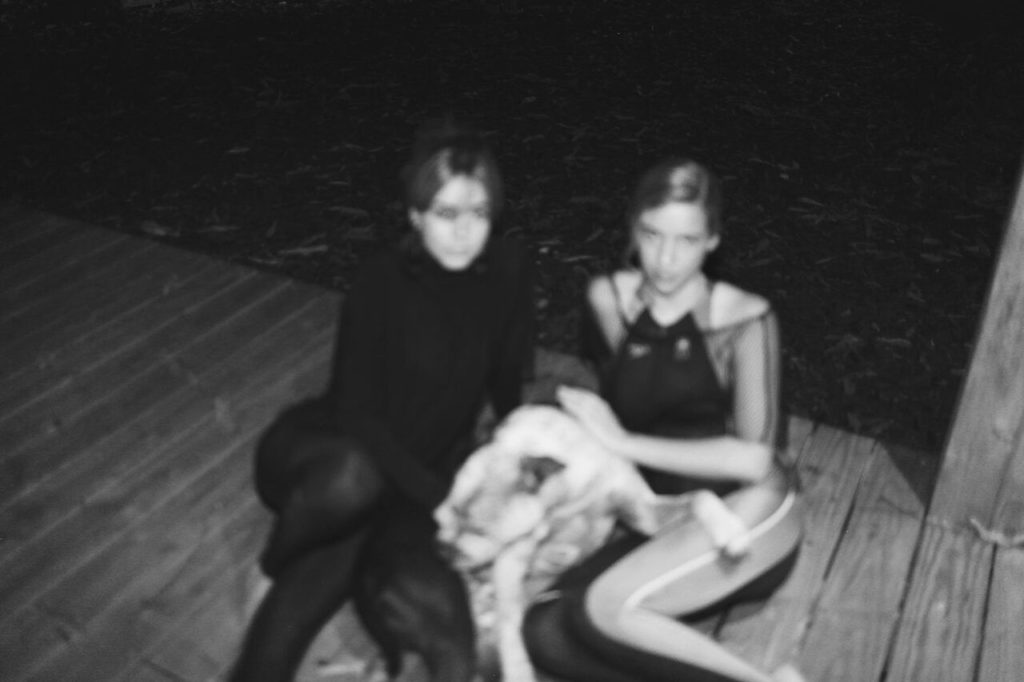By Angela Tornello
Miami-based techno duo, Jessica Martin, 23, and Emma del Rey, 22, met while studying visual arts at the New World School of the Arts in their current tropical stomping grounds. The two are the experimental forces behind musical endeavor Roseasia and roving venue CUBE. Martin is a Cuba native, and her collaborator grew up in South Florida. Each also expresses her individual rhythmic styles with solo projects: Martin has the amusingly titled Acissssssej, while del Rey works on both Autobahn and Baby Face del Rey II. Through Roseasia and CUBE, Martin and del Rey are changing the Miami musical landscape and creating their own techno domain in this southern enclave.
With CUBE, they are quite literally altering the landscape by creating alternative venues where they feel techno can really evolve. The project consists of a curated series of electronic music events. They launched CUBE in the slowly gentrifying Little Havana neighborhood in 2016. Documenting the activations at each space, CUBE is an effort to create an intimate dance environment where music Martin and del Ray feel isn’t being played enough elsewhere is available to everyone.
“CUBE is an actualized noun, a home base, a concrete space, but the curated series has transient potential possibilities,” Martin explains. They invite DJs and live acts to perform, building a diverse roster with sounds that challenge what we know of as electronic music. They are selecting noisier, harsher, more minimalistic sets with rhythmic variation throughout. They hope CUBE will not only exist in transience but will come to represent all the music Miami has to offer. The intent is to select not just local artists but ones who originated from Miami and have moved elsewhere to showcase a crossover of cultures and identities in their hybrid sounds. For instance, CUBE recently put together a set with solo percussionist and metal band Liturgy’s Greg Fox and local electro legend Uprokk.
When all you have is what you have, it’s raw, it is what it is, and then you get wild with it.
Roseasia feels that experiencing techno, within the context of a club environment, is meant to be communal and collaborative. So, they know the importance a space has in facilitating the connection between audiences with music makers. For a variety of reasons, they think making music outside of a traditional venue has additional value. “Employing a DIY standard in operation has a variety of bonuses. From the onset, the curation is not beholden to a commodity exchange the way a bar or nightclub is. Content is selected not based on alcohol sales or revenue but in qualitative, fresh programming for each event. The formalities of the club experience are often ones wrought with hostility from bouncers, advertisement, and a general lack of intimacy. The experience that CUBE hopes to sustain and build is one of community, one that sits outside the construct and constraints of the typical club environment,” del Rey elaborates. The two do say that there are a few other Miami venues that they favor for music, like weird-o Little Haiti gallery Space Mountain, roving experimental stage Miami Music Club, hip Wynwood haunt Gramps, and tried-and-true, anything-goes dive Churchill’s Pub.
They also hope to build upon and incorporate sounds of the past, merging Miami bass and electro with music that is more prevalent in the area, like reggaeton and Latin. “I am really excited and hopeful for the music scene here in Miami,” Martin says. “I want to have moments of challenge while listening to music here—something that is not so easy to listen to but that can push ideas and collaboration. I do think that this is happening here, slowly. Where you live shouldn’t dictate what movements and sounds you can be part of,” she says, referring to the city’s location, far from other large cities, which makes it harder for touring acts to visit and thus limits its residents’ access to a variety of acts and sounds. “Introducing music that is currently not prevalent in Miami and curating sounds that wouldn’t normally be put together creates a bigger conversation and cultural signature.”
With Roseasia, they work in the crossover space between art and sound compositions, often using forms and translating them into music. For example, what does a cube sound like? What does a line going up and down sound like? What does wet sound like? Martin started making music as a way to explore the visual narratives that could exist within sound. For del Rey, it was the fascination with creating an experience for someone else, through art or music, that led to her creative projects.

Martin is attracted to the repetition of a shape and the different interactions and patterns that result from the combination of simple elements. “In some ways, techno is a lot about the building up of certain sounds through layering and repetition. It’s a good format to dive into and alter,” she says. She is often on the road, spending countless hours driving as she commutes from the Everglades to Miami, and the constant repetition of the road is folded into her rhythmic landscape.
Forms, spheres, math, movement, the ocean, and time influence del Rey. “Two polyrhythms, intertwined but independent, rather slow and almost static, occasionally accelerating and decelerating, starting and ending together,” she muses about her work. She is drawn to the connections found between objects, between people, and between a person and an experience.
In addition to reconfiguring beats, Roseasia is reimagining equipment. Martin is focused on “hacking analog,” exploring an equipment’s duality and challenging it beyond its initial purpose. With sensory percussion, she feels there are endless possibilities. The use of triggers—triggering samples of other sounds and instruments—creates a space for infinite experimentations; she likes intertwining analog and digital, with the software and the drummer working in tandem. Martin has been coveting the Pearl Syncussion. Released in 1979, it sends the MIDI from a sequencer to produce a vast array of percussive sounds. The Syncussion takes drum patterns and beats and turns them into larger, deeper wavelengths, generating a bass-like sound. A minimalist setup is what Martin prefers—having one piece of equipment and seeing how far you can go with it. This past year, Martin has been making music based around gear she could borrow from friends, which made her think about the creative process in a completely different way. “When all you have is what you have, it’s raw, it is what it is, and then you get wild with it,” Martin says.
Roseasia is currently working on a yet-to-be-titled album that explores many generative compositions, rhythmic imbalances, and melodic structures. Also, del Ray is also working on a new collaborative music project as well as a music and art online publication. She’ll be showing some of her photography and sculpture at Miami’s Mindy Solomon Gallery in August and hopes to materialize ideas for an EP under her solo project for next year. Martin continues to work on her solo project and is also part of a design duo that goes under the moniker NUN. She’s been designing structures and objects since 2014 and recently started a new series of modular forms set to come out early 2018.
This article was featured in the Outlaw issue of Tom Tom. Purchase it online.


